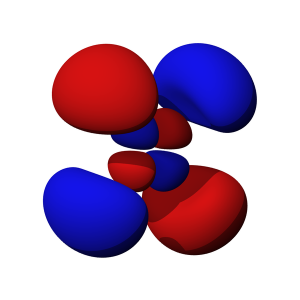
Chemistry is the study of the interactions of atoms, determined largely by the outermost or surface electrons.
Electron structure in atoms obeys the laws of quantum mechanics. They do not move randomly as if in some sort of cloud, but are organized into shells, subshells and orbitals.
Electron Structure in Atoms
Four quantum numbers are responsible for this structure. They are the principal quantum number, the azimuthal quantum number, the magnetic quantum number and the spin quantum number.
Principal Quantum Number – Shells
The principal quantum number, “n”, must be a positive integer. That is n = 1, 2, 3… This number dictates an electron’s energy level. Electrons fill the lowest energy level first, then the second energy level, the third and so on. But within a given energy level, there are additional requirements, in part determined by the second quantum number, the azimuthal quantum number.
Azimuthal Quantum Number – Subshells
Shells are divided into subshells. The azimuthal quantum number determines how that will happen. It addresses both orbital angular momentum and orbital shape. Increasing values of the azimuthal quantum number lead to s, p, d, f and g subshells. Because of their geometry, the “s” subshell can hold one orbital, the “p” can hold 3, “d” can hold 5, “f” can hold 7 and “g” can hold 9 orbitals.
Magnetic Quantum Number – Orbital Orientation
Orbitals are located in shells and subshells. They must also be oriented as to direction. For instance, a p subshell can have 3 orbitals. It is the magnetic quantum number that points it in the x-direction, the y-direction or the z-direction. For subshells that can hold more orbitals than 3, the directional pointing is more complex, but follows the same principles.
Spin Quantum Number
Electrons can have one of two different electron spins. This enables two to pair up without interference in any given orbital.
Examples
Sodium 1s² 2s² 2p⁶ 3s¹
Calcium 1s² 2s² 2p⁶ 3s² 3p⁶ 4s²
Lead 1s² 2s² 2p⁶ 3s² 3p⁶ 4s² 3d¹⁰ 4p⁶ 5s² 4d¹⁰ 5p⁶ 6s² 4f¹⁴ 5d¹⁰ 6p²
Note: You might also enjoy Atomic Electron Quantum Numbers Overview
References:
← Back to Classic Science
← Home
